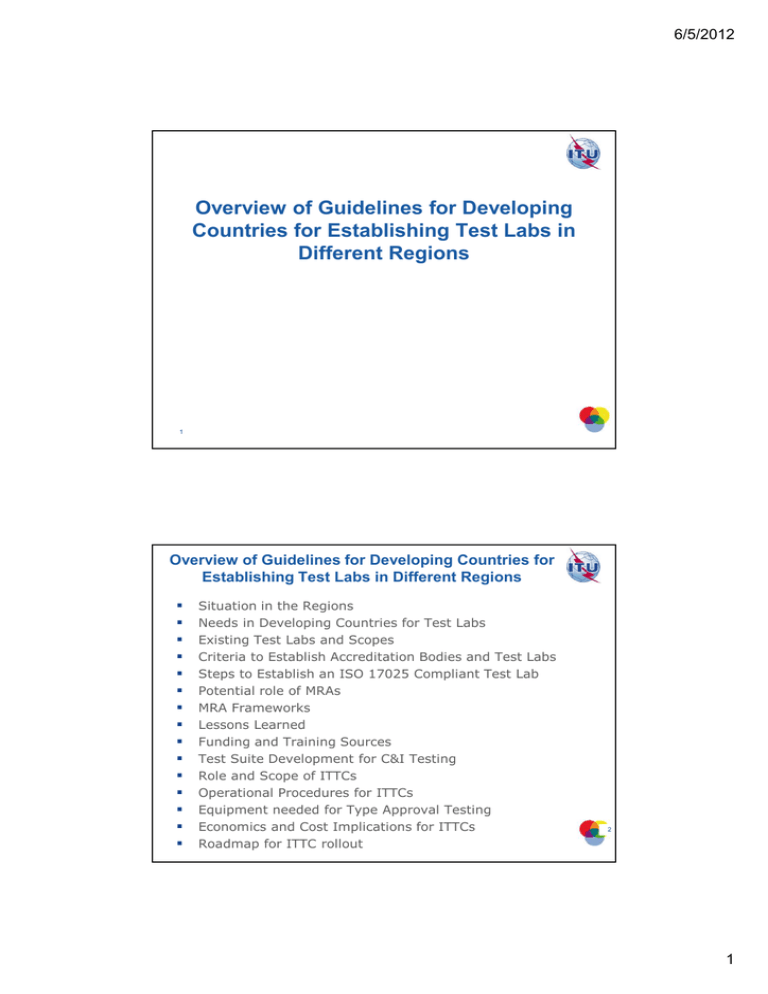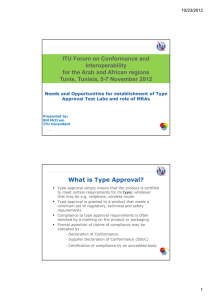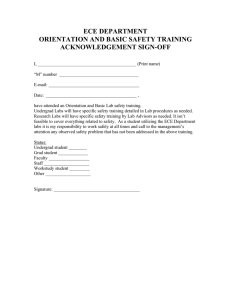Overview of Guidelines for Developing Countries for Establishing Test Labs in 6/5/2012
advertisement

6/5/2012 Overview of Guidelines for Developing Countries for Establishing Test Labs in Different Regions 1 Overview of Guidelines for Developing Countries for Establishing Test Labs in Different Regions Situation in the Regions Needs in Developing Countries for Test Labs Existing Test Labs and Scopes Criteria to Establish Accreditation Bodies and Test Labs Steps to Establish an ISO 17025 Compliant Test Lab Potential role of MRAs MRA Frameworks Lessons Learned Funding and Training Sources Test Suite Development for C&I Testing Role and Scope of ITTCs Operational Procedures for ITTCs Equipment needed for Type Approval Testing Economics and Cost Implications for ITTCs Roadmap for ITTC rollout 2 1 6/5/2012 Situation in the Regions Widespread non interoperability of systems and equipment Few countries with mandatory import requirements for telecom equipment Absence of technical standards which are required to be met and no market surveillance or enforcement Counterfeit and sub standard equipment creating chaos in the marketplace Few or no local C&I test labs Regional Test Lab solutions are an urgent requirement 3 Needs in Developing Countries for Test Labs Access to test labs for assessing conformity to standards is an essential need for creating an orderly telecom apparatus marketplace Once standards are in place, test labs can check equipment for compliance Test lab services can be shared amongst countries and regions and must have sufficient scope to address priority problem areas Regional test labs represent a potential way to meet this need with shared costs and results A robust framework is needed for trust and confidence in test results and among test labs 4 2 6/5/2012 Existing Test Labs and Scopes Test labs for type approval and interoperability are in operation, but mainly in developed economies ITU consultations and Workshops in Nairobi, Ghana and other places showed an active interest and need for Type Approval labs now Tanzania, as an example, has established advanced requirements for a Type Approval lab with comprehensive scope Test lab scopes include wireless, wireline and broadcast equipment plus SAR and EMC compliance testing 5 Criteria to Establish Accreditation Bodies and Test Labs ISO/IEC has established a set of internationally accepted standards (CASCO Toolbox) which give gold standard credentials to compliant accreditation, certification and test bodies These form foundational elements for both trusted services and for framework agreements for sharing services The Guidelines provide substantial detail on the various criteria 6 3 6/5/2012 Steps to Establish an ISO 17025 Compliant Test Lab The steps which are detailed in the Guidelines include: Management requirements and systems for the lab Lab requirements, test methods and procedures, audits, equipment handling Document control, calibration records and staff records Handling of test reports and calibration certificates Service to customers and handling of complaints 7 Potential role of MRAs MRAs can provide an acceptable framework for sharing of testing services and results MRAs can permit a single test lab to service local, regional and international parties based on established international credentials MRAs can minimize the capital investment needed in Conformity Assessment Bodies in a region through sharing of services and results MRAs can form the first step towards a more efficient global test arrangement of “one test, done once, accepted everywhere” 8 4 6/5/2012 MRA Frameworks MRA frameworks serve to identify the key elements of trust in cooperative activities amongst Conformity Assessment Bodies (CABs) and their oversight MRA frameworks provide a standing record of the intentions and obligations of each party MRA frameworks identify the scope of operations, technical requirements, mandatory testing, and marking requirements MRA frameworks permit formalizing such collaborative and cooperative activities with underpinning credentials identified and clarified 9 Lessons Learned A number of international MRAs are in place and are detailed in the Guidelines report Lessons learned include the kinds of costs and time to market savings through use of MRAs Additional lessons learned point to a substantial increase in transparency of market access through exposure of importation requirements – no hidden re-testing, no import licensing, no queue-jumping for service MRAs permit suppliers to access lowest cost service providers and to have wider choices of test lab services 10 5 6/5/2012 Funding and Training Sources Many sources of funding and training worldwide are identified in the Guidelines: Funding bodies referenced in an extensive Appendix include UNIDO, major Banks in each region, specialized funding agencies for telecoms projects and others Requirements to access funds vary from low interest loans, to grants, seed funding and cost underwriting Sample well known telecom training organizations operating internationally in various regions are listed These training organizations offer training for which costs vary from just travel to and from location, to government and supplier subsidized training, to private for-profit fully costed training. 11 Test Suite Development for C&I Testing Test specifications come in different forms and from various sources, including the ITU The ITU is the primary source for specifying the technologies and producing the standards for which conformance and interoperability testing is planned. Due to the breadth of ITU leading-edge ICT standards development, the ITU is currently determining the optimal set of standards to become candidates for test suite development Formal Test Specification Techniques include Protocol Implementation Conformance Statements (PICS), PICS Proforma, Test Suites, Test Suite Structure and Test Purposes (TSS & TP), Protocol Implementation eXtra Information for Testing (PIXIT), and Abstract Test Suites (ATS) Sources for test specification development The ITU has a long history and experience with the development of test specifications, detailing the requirements and options within its standards and facilitating conformance testing – utilizing formal methodologies. ITU-T Recommendations cover a very wide range of protocols, architectures, services, and systems. Other SDOs (e.g., ATIS, CableLabs, CCSA, ETSI, IEEE, IETF, ISO/IEC, OMA, 3GPP/3GPP2, TIA, TTA, TTC) have also developed test specifications for many technologies The ITU should focus test suite development on its current leading-edge technologies, including Fixed-Mobile Convergence, Broadcast/Multicast, Optical Networks, Multimedia and IPTV, QoS/QoE, Intelligent Transportation Systems, Smart Grid, M2M Communications, Cloud Computing The ITU should expand its test suite creation program to support conformance and interoperability testing, thereby accelerating ITU standards-based product deployment Feedback from conformance testing should be used to improve standards Regional ITTCs should take advantage of all sources available to obtain test suites for Regionally deployed technologies 12 6 6/5/2012 Role and Scope of ITTCs ITTC testing programs offered should be developed to address certification practices, technologies implemented and technology trends of the Region ITTCs should focus on capacity building and training programs, given the accumulated experience with testing current and evolving technologies in the Region Experience gained in performing complex networking tests could lead to a unified set of equipment requirements, unified network solutions, and improved QoS/QoE Testing programs for an ITTC should include Conformance testing Broad enough in scope to cover multiple technologies Complementary to other test labs/certification activities in the Region Interoperability testing Complementary to conformance testing Must support complex system/service testing (ITU-T “model network” concept) Type approval testing (if warranted). Lab unit modularity allows some flexibility in building out these facilities. Depending upon the Regional solution selected, ITTC functional capabilities may include: Configuring, calibrating, and testing appropriate telecommunications and measurement equipment Configuring a model network infrastructure for complex interoperability testing of systems and services Provisioning of training on testing procedures and new technologies 13 Operational Procedures for ITTCs ITTC Operations must include business procedures, certification procedures, and test program operations Business operations should include: – Customer interface (marketing, reception, etc.) – Financial operations and billing systems – Data base/Document filing system – Training programs – Shipping and receiving Certification procedures should include: Equipment certification, inspection, maintenance Test program operations should include: – Test lab operations (e.g., Calibration lab, Model Network lab, Wireless test lab, Wireline test lab) – Component Testing (Functional testing, Load and Stress testing, Conformance testing – Comprehensive Network and Services Testing for Complex Systems (Functional testing, Interconnect testing, Service testing, End-to-End testing, QoS testing, Mobility & Roaming testing) 14 7 6/5/2012 Equipment Requirements for ITTC Testing Programs ITTC test equipment requirements will depend on the Regional technologies supported and network evolution plans Conformance testing must support testing of standards implemented in a variety of equipment types. Testing of standards and equipment specifications requires a methodical analysis of test cases. An automated test execution environment (utilizing TTCN-3) is encouraged. Interoperability testing is complementary to conformance testing and must support complex system/service testing (ITU-T “model network” concept) The Model Network Test lab needs to be flexible to address numerous test architectures. Testing of typical NGN service scenarios require: Media Gateway Controllers (MGC), Proxy Servers SIP (PS), Signaling Gateways (SG), IP Multimedia Subsystem (IMS), Media Gateways (GW), Transport Network Environment (TNE), Application Servers (AS), Media servers (MS), Messaging Servers (MeS), Management System (MS), Billing system (BS), NGN Access Devices (NGN-AD), Media Gateway for Legacy Terminal Equipment (GW-LTE) Type approval testing equipment must support calibration testing as well as a variety of wireline and wireless equipment tests Specialized facilities are also required, such as EM shielded rooms, Anechoic chambers, EMC test equipment, SAR test systems, Environmental chambers, and Open Area Test Sites (OATS) 15 Economics and Cost Implications for ITTCs A Regional Testing Center has the potential advantage of size and the potential of being a center of excellence for testing expertise and training. Economies of scale can permit focus and specialization of processes and tools not otherwise available. An assessment of current and planned network services and technologies must be completed to prioritize the construction of labs and equipment for conformance testing, interoperability testing and type approval Region-specific data (funding, expertise, certification experience, network services deployed) is necessary to determine the test program, initial facility size, and scope of a Regional ITTC Assuming the total plan (including envisioned future expansion) cannot be funded immediately, the technology and test program priorities will drive the development of phases for the rollout plan Modular design enables flexibility for initial lab scope, expansion decisions, and costs Test lab modules could include: wireless test lab, wireline test lab, calibration lab, model network test lab, anechoic chamber, OATS, etc Type Approval testing may be required in some cases – requiring additional, different and potentially costly facilities Producing test specifications within the ITTC and/or contracting to produce specifications could be costly and time-consuming A system must be in place to identify and obtain the required test specifications 16 8 6/5/2012 Roadmap for ITTC rollout Developing plans and committing resources to establish an ITTC is a large undertaking, requiring analysis of Regional technology deployment and plans, market factors, funding levels, testing expertise, certification experience, and many other factors. A roadmap provides a methodical means of considering the factors involved with such a project. Except for financial considerations, the most important factor in planning a Regional Test Center are technology considerations Technologies currently in use (market penetration, service maturity). New and planned technologies and services, Network interconnections for new systems The assumptions for testing programs will determine the ultimate facility (i.e., building, total floor space, lab space, office space, operations space) The ITTC rollout should include several phases: Start-up Phase: Facility (purchase, lease or build facility - with considerations for future expansion), Special requirements for sensitive equipment (shielding from environmental factors (temperature, noise, vibration, etc), Special construction for power requirements; Business operations (Reception, Financial operations and billing systems, Hiring of staff, experts, Training programs, Data base/Document filing system, Shipping and receiving); Lab certifications; Equipment calibration Initial Operations Phase: Test labs for highest priority technologies and services (Conformance test lab; Model Network test bed, Wireless Test lab, etc); Type Approval Lab (Optional); Equipment calibration, inspection, maintenance (ongoing) Later Phases: Test labs to cover lower priority technologies and services 17 Conclusions and Recommendations from the Guidelines The Guidelines will have the following recommendations, among others: Members to advise the ITU of interoperability problems, their mitigation, and successful procedures that were helpful in the process Members to establish market access requirements for telecom equipment to avoid interference, network harm and safety of life issues in their marketplace. Members to examine their existing legislation and regulations to ensure that they enable participation in MRAs on Conformity Assessment and testing with foreign partners Members to prioritize areas of concern related to telecommunication products and systems Accreditation bodies in member states should become signatories of the ILAC MRA or the IAF MLA. Regional groups such as the African region to develop a framework MRA similar to the APEC TEL MRA or the Inter-American MRA Test centres should be established on a regional basis to take advantage of the similar networks in a region with common infrastructures 18 9


